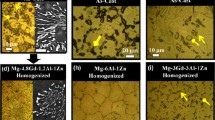Diffusion zone growth kinetics and its phase composition after heat treatment of the bimetal obtained by explosive welding of copper M1 + magnesium alloy MA2-1 are studied. Thermal conductivity of a bimetal after welding and diffusion annealing are evaluated. The change in the textural state of magnesium alloy due to structural distortions during the formation of new phases is demonstrated.







Similar content being viewed by others
References
M. Burkhardt, et al., “Leaching of biocides from facades under natural weather conditions,” Environmental Science and Technology,46, No. 10, 5497–5503 (2012); DOI: https://doi.org/10.1021/es2040009.
A. Khubaev, “Modern Russian high-tech construction materials and their application in domestic construction industry (on example of metal-ceramic panels Hardwall),” J. of Physics: Conf. Series,365, No. 3, 032005 (2018); DOI: 10.1088/1757899X/365/3/032005.
G. Lee and S. Kim, “Case study of mass customization of double curved metal facade panels using a new hybrid sheet metal processing technique,” J. of Construction Engineering and Management,138. No. 11, 1322–1330 (2012); DOI: 10.1061/(ASCE) CO.19437862.0000551.
M. Kuhnhenne, et al., “Building redevelopment – Solutions for roof and facade using lightweight steel construction,” Article@Bauen im Bestand – Lösungen für Dach und Fassade in Stahlleichtbauweise. Stahlbau,86, No. 10, 862–872 (2017); DOI: https://doi.org/10.1002/stab.201710535.
B. I. Ireland, “Inappropriate specs and unnecessary costs,” Construction Specifier,56, No. 7, 98 (2003).
M. Eekhout and P. De Rotten, “Development of a super slim facade system for InHolland Polytechnic, Delft,” in: Challenging Glass 2 – Conference on Architectural and Structural Applications of Glass, CGC (2010), pp. 657–666.
N. N. Brovkova and V. N. Brovkova, “Using copper-ore flotation residues in the production of facade tiles,” Glass and Ceramics,36, No. 1, 38–40 (1979); DOI: https://doi.org/10.1007/BF00697377.
F. Monna, et al., “Geochemical records of limestone facades exposed to urban atmospheric contamination as monitoring tools?” Atmospheric Environment,42, No. 6, 999–1011 (2008); DOI: https://doi.org/10.1016/j.atmosenv.2007.10.021.
E. F. Émli, Bases of Manufacturing Technology and Treatment of Magnesium Alloys [in Russian], Metallurgiya, Moscow (1972).
G. P. Fetisov (editor), Metal Materials Science and Technology [in Russian], 3rd. ed., Vysshaya Shkola, Moscow (2005).
N. Cortés, et al., “Thermomechanical characterization of Al–Cu–Mg composites reinforced with diboride particles,” TMS Annual Meeting,3, 185–192 (2010).
M. A. El-Gammal, A. M. El-Alfy, and N. M. Mohamed, “Using magnesium oxide wallboard as an alternative building facade cladding material in modern Cairo buildings,” J. of Applied Sci. Research,8, No. 4, 2024–2032 (2012).
M .A. Boller and M. Steiner, “Diffuse emission and control of copper in urban surface runoff,” Water Sci. and Technology,46, No. 6–7, 173–181 (2002).
N. P. Lyakishev (editor), Compistiion Diagrams for Binary Metal Systems: Handbook in 3 vol. [in Russian], Vol. 1, Mashninostroenie (1996).
D. V. Pronichev, Yu. P. Trykov, L. M. Gurevich, and O. V. Slaution, “Study of thermal conductivity of layered metal composites,” Coll. “Problems of materials science of, welding, and strength in engineering,” Izv. Volg. GTU, Issue 1, No. 3, 33–36 (2007).
V. G. Shmorgun, L. M. Gurevich, O. V. Slautin, V. N. Arisova, and D. A. Evstropov, “Formation of coatings based on titanium carbide at the surface of copper with contact fusion,” Metallurg, No. 10, 88092 (2015).
V. G. Shmorgun, O. V. Slautin, and D. A. Evstropov, “Effect of contact pressure regimes on the structure and properties of a coating of the copper-titanium system,” Metallurg., No. 6, 83–86 (2016).
A. A. Akhkubekov, T. A. Orkvasov, and V. A. Sozaev, Contact Pressure of Metals and Nano-Structures: Monograph [in Russian], Zizmatlit, Moscow (2008).
L. M. Gurevich, Yu. P. Trykov, V. N. Arisova, and I. A. Ponomareva, “Effect of heat treatment on formation of elements of the fine structure of magnesium-aluminum composite after explosive welding and bending,” Coll. “Problems of materials science of, welding, and strength in engineering,” Izv. Volg. GTU, Issue 10, No. 23, 6–11 (2014).
Author information
Authors and Affiliations
Corresponding author
Additional information
Translated from Metallurg, Vol. 63, No. 10, pp. 104–109, October, 2019.
Rights and permissions
About this article
Cite this article
Shmorgun, V.G., Slautin, O.V., Arisоva, V.N. et al. Structure and Phase Composition of Diffusion Zone in Copper M1 + Alloy MA2-1 Composite. Metallurgist 63, 1124–1131 (2020). https://doi.org/10.1007/s11015-020-00930-z
Received:
Published:
Issue Date:
DOI: https://doi.org/10.1007/s11015-020-00930-z




